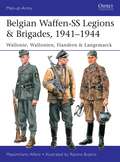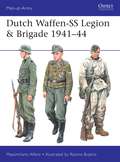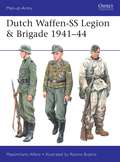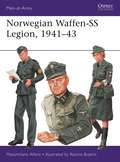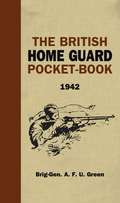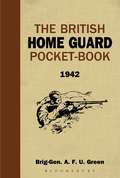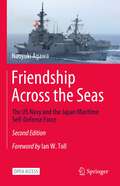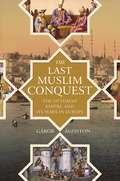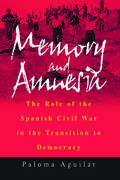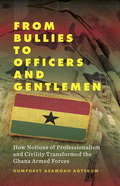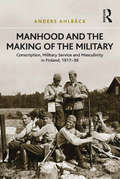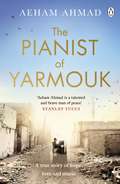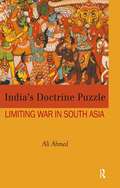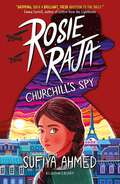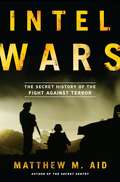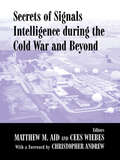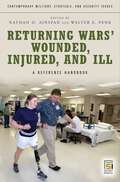- Table View
- List View
Belgian Waffen-SS Legions & Brigades, 1941–1944: Wallonie, Wallonien, Flandern & Langemarck (Men-at-Arms)
by Massimiliano AfieroFrom the German occupation of Belgium in May 1940, Flemish recruits from northern Belgium – considered by the Nazis to be 'Germanic' – were accepted individually into Waffen-SS units. From Hitler's invasion of the USSR in June 1941, additional recruits from the French-speaking south (Wallonia) were drafted. Both communities formed volunteer 'Legions', to fight (according to Goebbels' propaganda machine) 'for European civilization against the Bolshevik threat'; these were a Flemish Legion in the Waffen-SS and a Walloon Legion in the German Army. Both served on the Russian Front in 1942-43; the Walloon Legion was then also transferred into the Waffen-SS, and the decorated Walloon officer Leon Degrelle became a publicized 'poster boy' for foreign SS volunteers. Both Legions were then redesignated as SS Assault Brigades, and thereafter saw extremely hard fighting in the Ukraine and on the Baltic front. In autumn 1944, their survivors were withdrawn from the front and incorporated into two new understrength SS Divisions, 27. 'Langemarck' and 28. 'Wallonien'.This new account, featuring detailed colour plates of uniform and insignia, recounts the battle history of the French and Flemish-speaking Belgian SS, up to their final transformation into full divisions in the winter of 1944/45.
Dutch Waffen-SS Legion & Brigade 1941–44 (Men-at-Arms)
by Massimiliano AfieroGoebbels' 1941 propaganda campaign to present Germany's invasion of the USSR as a battle for European civilization against Asian barbarism convinced many men in occupied 'Germanic' European countries, such as Scandinavia and the Low Countries, to volunteer to fight on the Russian Front. One of the strongest national legions of such a kind was raised in the Netherlands, where it was supported by a large pro-Nazi movement led by Anton Mussert. The 3,000-man Netherlands Volunteer Legion fought on the Leningrad front in regimental strength, from the Red Army's winter 1941/42 counter-offensive until April 1943. The survivors were then reinforced to form a 5,500-strong Panzergrenadier Brigade, and after anti-partisan service in Croatia, they returned to Army Group North as part of Steiner's III SS Panzer Korps, fighting in the most arduous battles of 1943–44 until driven back into Pomerania. In the final months of the war the division formed the nucleus of the new 23rd SS Volunteer Panzergrenadier Division 'Nederland'.In this illustrated study of the Dutch Waffen-SS Legion and Brigade, specialist Massimiliano Afiero explores the full history of this important formation from its establishment in 1941 until it was incorporated into the 'Nederland' Division in 1944. Contemporary photographs and full-colour illustrations support the text and reveal key details including aspects of uniform and insignia.
Dutch Waffen-SS Legion & Brigade 1941–44 (Men-at-Arms)
by Massimiliano AfieroGoebbels' 1941 propaganda campaign to present Germany's invasion of the USSR as a battle for European civilization against Asian barbarism convinced many men in occupied 'Germanic' European countries, such as Scandinavia and the Low Countries, to volunteer to fight on the Russian Front. One of the strongest national legions of such a kind was raised in the Netherlands, where it was supported by a large pro-Nazi movement led by Anton Mussert. The 3,000-man Netherlands Volunteer Legion fought on the Leningrad front in regimental strength, from the Red Army's winter 1941/42 counter-offensive until April 1943. The survivors were then reinforced to form a 5,500-strong Panzergrenadier Brigade, and after anti-partisan service in Croatia, they returned to Army Group North as part of Steiner's III SS Panzer Korps, fighting in the most arduous battles of 1943–44 until driven back into Pomerania. In the final months of the war the division formed the nucleus of the new 23rd SS Volunteer Panzergrenadier Division 'Nederland'.In this illustrated study of the Dutch Waffen-SS Legion and Brigade, specialist Massimiliano Afiero explores the full history of this important formation from its establishment in 1941 until it was incorporated into the 'Nederland' Division in 1944. Contemporary photographs and full-colour illustrations support the text and reveal key details including aspects of uniform and insignia.
Norwegian Waffen-SS Legion, 1941–43 (Men-at-Arms)
by Massimiliano AfieroFollowing the Nazi occupation of Norway in 1941, the Waffen-SS began recruiting volunteers to serve in their ranks. Initially formed into small volunteer units, these developed into large divisions by 1943, referred to as 'Legions' in Nazi propaganda. Early volunteers were promised that they would not leave Scandinavia and that they would serve under native Norwegian officers – but after the German invasion of the Soviet Union they were deployed to the Leningrad front alongside Dutch and Latvian units, in the 2nd SS Infantry Brigade. These units combined to form the nucleus of a whole regiment within the new 11th SS Volunteer Panzergrenadier Division 'Nordland'.Fully illustrated with detailed artwork depicting the uniforms and equipment of the volunteer soldiers, this fascinating study tells the little-known story of the Norwegians who fought with the SS in World War II.
Norwegian Waffen-SS Legion, 1941–43 (Men-at-Arms #524)
by Massimiliano AfieroFollowing the Nazi occupation of Norway in 1941, the Waffen-SS began recruiting volunteers to serve in their ranks. Initially formed into small volunteer units, these developed into large divisions by 1943, referred to as 'Legions' in Nazi propaganda. Early volunteers were promised that they would not leave Scandinavia and that they would serve under native Norwegian officers – but after the German invasion of the Soviet Union they were deployed to the Leningrad front alongside Dutch and Latvian units, in the 2nd SS Infantry Brigade. These units combined to form the nucleus of a whole regiment within the new 11th SS Volunteer Panzergrenadier Division 'Nordland'.Fully illustrated with detailed artwork depicting the uniforms and equipment of the volunteer soldiers, this fascinating study tells the little-known story of the Norwegians who fought with the SS in World War II.
The British Home Guard Pocketbook
by A.F.U. GreenThe Home Guards are an attacking force lying in wait for, and ready to destroy, and enemy who dares to set foot on out shores.' The Home Guard has been immortalised in British culture in the TV series Dad's Army. Formed by men not eligible for active service – too old, too young, in reserved occupations vital to the war effort – who were expected to resist a German invasion with any resources they had to hand, the Home Guard is the embodiment of plucky British resolve against the odds. The Home Guard Pocket-Book evokes this spirit. Written by Brig-Gen Green, commanding 4th battalion, Sussex Home Guard and Training Adviser for the Sussex Zone, this book is based on his experience and, in his own words, 'is the result of my ransacking the dusty pigeon-holes of memory and the condensation of many books, official instructions and writings'. Its tone is informal and colloquial, such as: 'March discipline. Troops will always march off the parade ground at the Slope. As soon as this has been done the order "March at Ease" should be given. When marching at ease the rifle may be carried in any way a soldier fancies.' Nevertheless, the book is full of sound advice on training, organisation and discipline, fire arms, reconnaissance and field engineering, the responsibilities of the Group Pigeon Officer, the proper position to adopt for surviving a dive bomb attack, and how to set a trap for an unwary advancing German cyclist!
The British Home Guard Pocketbook
by A.F.U. GreenThe Home Guards are an attacking force lying in wait for, and ready to destroy, and enemy who dares to set foot on out shores.' The Home Guard has been immortalised in British culture in the TV series Dad's Army. Formed by men not eligible for active service – too old, too young, in reserved occupations vital to the war effort – who were expected to resist a German invasion with any resources they had to hand, the Home Guard is the embodiment of plucky British resolve against the odds. The Home Guard Pocket-Book evokes this spirit. Written by Brig-Gen Green, commanding 4th battalion, Sussex Home Guard and Training Adviser for the Sussex Zone, this book is based on his experience and, in his own words, 'is the result of my ransacking the dusty pigeon-holes of memory and the condensation of many books, official instructions and writings'. Its tone is informal and colloquial, such as: 'March discipline. Troops will always march off the parade ground at the Slope. As soon as this has been done the order "March at Ease" should be given. When marching at ease the rifle may be carried in any way a soldier fancies.' Nevertheless, the book is full of sound advice on training, organisation and discipline, fire arms, reconnaissance and field engineering, the responsibilities of the Group Pigeon Officer, the proper position to adopt for surviving a dive bomb attack, and how to set a trap for an unwary advancing German cyclist!
Friendship Across the Seas: The US Navy and the Japan Maritime Self-Defense Force
by Naoyuki AgawaThis Open Access book describes the history of the relationship between the Japan Maritime Self-Defense Force (JMSDF), the heir to the Imperial Japanese Navy (IJN), and the United States Navy (US Navy), with a focus on the individuals who helped build it. Former enemies who fought fiercely on the seas and in the air during the Pacific War, the two navies came to respect each other in action. Soon after the war, when the Cold War turned hot, they began to work together as allies, driven by their respective national interests. With the generous assistance of the US Navy, the JMSDF was established as its counterpart. Over the years, these two navies have gradually built strong ties. Individual officers and sailors on both sides overcame mixed feelings about their erstwhile foes to feel respect for and trust in each other. This was made possible by conducting countless joint exercises and operations at sea. US Navy leaders began to realize that this small maritime force, notwithstanding domestic political, constitutional, and legal limitations, does its job well, is reliable, and can be fully trusted. The JMSDF realized that, sharing common interests and values, there was no better navy in the Asia-Pacific region to ally with. Over seventy years of accumulated shared experiences have transformed this into perhaps the most successful navy-to-navy partnership in the world. The US-Japan maritime alliance today is anchored in this history. Numerous admirals, officers, and sailors of the two navies working together have greatly contributed to the stability and prosperity of the Asia-Pacific region for the past seven decades. This book is intended for readers interested in the history of US-Japan relations and for naval officers and sailors from the US and other countries. It is the author’s sincere desire that they read this book and appreciate the longstanding cooperation between the JMSDF and the US Navy.
The Last Muslim Conquest: The Ottoman Empire and Its Wars in Europe
by Gábor ÁgostonA monumental work of history that reveals the Ottoman dynasty's important role in the emergence of early modern EuropeThe Ottomans have long been viewed as despots who conquered through sheer military might, and whose dynasty was peripheral to those of Europe. The Last Muslim Conquest transforms our understanding of the Ottoman Empire, showing how Ottoman statecraft was far more pragmatic and sophisticated than previously acknowledged, and how the Ottoman dynasty was a crucial player in the power struggles of early modern Europe.In this panoramic and multifaceted book, Gábor Ágoston captures the grand sweep of Ottoman history, from the dynasty's stunning rise to power at the turn of the fourteenth century to the Siege of Vienna in 1683, which brought an end to Ottoman incursions into central Europe. He discusses how the Ottoman wars of conquest gave rise to the imperial rivalry with the Habsburgs, and brings vividly to life the intrigues of sultans, kings, popes, and spies. Ágoston examines the subtler methods of Ottoman conquest, such as dynastic marriages and the incorporation of conquered peoples into the Ottoman administration, and argues that while the Ottoman Empire was shaped by Turkish, Iranian, and Islamic influences, it was also an integral part of Europe and was, in many ways, a European empire.Rich in narrative detail, The Last Muslim Conquest looks at Ottoman military capabilities, frontier management, law, diplomacy, and intelligence, offering new perspectives on the gradual shift in power between the Ottomans and their European rivals and reframing the old story of Ottoman decline.
Memory and Amnesia: The Role of the Spanish Civil War in the Transition to Democracy
by Paloma AguilarUsing a rich variety of sources such as official newsreels, school textbooks, the work of contemporary historians, memoirs, official documents, legislation, and monuments, this book explores how the historical memory of the Spanish Civil War (1936-1939) influenced the transition to democracy in Spain after Franco's death in 1975. The author traces the development of official discourse on the War throughout the Franco period and describes the régime's attempts to achieve political legitimacy. Although there was no universal consensus regarding the events of the Civil War, general agreement did exist concerning the main lesson which should be drawn from it: never again should Spaniards become embroiled in a fratricidal conflict.
From Bullies to Officers and Gentlemen: How Notions of Professionalism and Civility Transformed the Ghana Armed Forces
by Humphrey Asamoah AgyekumBased on unprecedented access to the Ghanaian military barracks and inspired by the recent resurgence of coups in West Africa, Agyekum assesses why and how the Ghana Armed Forces were transformed from an organization that actively orchestrated coups into an institution that accepts the authority of the democratically elected civilian government. Focusing on the process of professionalization of the Ghanaian military, this ethnography based monograph examines both historical and contemporary themes, and assesses the shift in military personnel from ‘Buga Buga’ soldiers – uneducated, lower-class soldiers, human rights abusers – to a more ‘modern’ fighting force.
Bertie Ahern Autobiography: The Autobiography
by Bertie AhernBertie Ahern, three times Irish Taoiseach, is often described as an enigma. The Old IRA man's son who delivered peace in Northern Ireland. A working class boy responsible for the Celtic Tiger. The man of faith who ushered in progressive, cosmopolitan secular Ireland. An ardent nationalist admired by European leaders. 'I know 25 per cent of Bertie Ahern', said his finance minister, Charlie McCreevy, 'and that's 24 per cent more than anyone else.'Now in this frank and revealing autobiography, Ahern gives his own account of a remarkable political life and the personal story that accompanies it. He shows the cost to his family of a life played out in the public eye and, for the first time, discloses what really happened in his final weeks in power.Here for the first time is the truth behind the man who is Bertie.Ahern has been at the cutting edge of Irish politics for over three decades. He was first elected to Dáil Éireann in the Fianna Fáil landslide victory in 1977 that saw Jack Lynch returned as Taoiseach. In 1982, Charles Haughey appointed him Government Chief Whip. In volatile political times, he strongly supported Haughey during three challenges to his leadership of Fianna Fáil.In 1987, Bertie Ahern received his first cabinet portfolio as Minister for Labour. It was a time when the Irish economy was in crisis. Ireland had a higher debt per head than Ethiopia or Sudan. Unemployment stood at 16%. Ahern negotiated Ireland's first social partnership agreement, which underpinned economic recovery and put in place the foundations for a period of sustained growth. In 1991, he was appointed Minister for Finance. International commentators first began to refer to 'Ireland's Tiger economy' in this period. When Bertie Ahern left the Department of Finance in late 1994, for the first time in almost 30 years, Ireland had a budget surplus.Bertie Ahern succeeded Albert Reynolds as leader of Fianna Fáil in November 1994. Following the General Election in 1997, he became Ireland's youngest ever Taoiseach. The Ahern Era was a time of unprecedented progress in Irish society. Over the course of his tenure in office, Ireland's economy out-performed that of every other European country. For the first time ever, the number of people in employment in the State reached 2 million.Working closely with Bill Clinton and Tony Blair, Ahern won widespread acclaim for his perseverance and skill in negotiating the Good Friday Agreement, which has provided the political framework for a lasting peace in Northern Ireland.On the international stage, he was a respected figure who enjoyed an acclaimed Presidency of the European Council in 2004. He presided over the completion of the largest ever expansion of the EU and concluded negotiations on a European constitution. He is one of only five visiting statesmen to have addressed both the United States Congress and the Houses of Parliament in Westminster.At home, Ahern enjoyed phenomenal electoral support. He was the first Taoiseach since 1944 to win three successive General Elections.Bertie Ahern resigned on 6th May, 2008. He had served for ten years, ten months and ten days as Taoiseach.
Manhood and the Making of the Military: Conscription, Military Service and Masculinity in Finland, 1917–39
by Anders AhlbäckWhen Finland gained its independence from Russia in 1917, the country had not had a military for almost two decades. The ensuing creation of a new national conscript army aroused intense but conflicting emotions among the Finns. This book examines how a modern conscript army, born out of a civil war, had to struggle through social, cultural and political minefields to find popular acceptance. Exploring the ways that images of manhood were used in the controversies, it reveals the conflicts surrounding compulsory military service in a democratic society and the compromises made as the new nation had to develop the will and skill to defend itself. Through the lens of masculinity, another picture of conscription emerges, offering new understandings of why military service was resisted and supported, dreaded and celebrated in Finnish society. Intertwined with the story of the making of the military runs the story of how manhood was made and remade through the idealized images and real-life experiences of conscripted soldiers. Placing interwar Finland within a broad European context, the book traces the origins of competing military traditions and ideological visions of modern male citizenship back to their continental origins. It contributes to the need for studies on the impact of the Great War on masculinities and constructions of gender among military cultures in the peacetime period between the two world wars.
Manhood and the Making of the Military: Conscription, Military Service and Masculinity in Finland, 1917–39
by Anders AhlbäckWhen Finland gained its independence from Russia in 1917, the country had not had a military for almost two decades. The ensuing creation of a new national conscript army aroused intense but conflicting emotions among the Finns. This book examines how a modern conscript army, born out of a civil war, had to struggle through social, cultural and political minefields to find popular acceptance. Exploring the ways that images of manhood were used in the controversies, it reveals the conflicts surrounding compulsory military service in a democratic society and the compromises made as the new nation had to develop the will and skill to defend itself. Through the lens of masculinity, another picture of conscription emerges, offering new understandings of why military service was resisted and supported, dreaded and celebrated in Finnish society. Intertwined with the story of the making of the military runs the story of how manhood was made and remade through the idealized images and real-life experiences of conscripted soldiers. Placing interwar Finland within a broad European context, the book traces the origins of competing military traditions and ideological visions of modern male citizenship back to their continental origins. It contributes to the need for studies on the impact of the Great War on masculinities and constructions of gender among military cultures in the peacetime period between the two world wars.
The Pianist of Yarmouk
by Aeham AhmadThe moving story of one young man's struggle to find peace during war, and the power of music to bring hope to a desperate nation. BBC Radio 4 'Book of the Week'__________A man, a piano, a Syrian street under siege . . .One morning on the outskirts of war-torn Damascus, a starving man stumbles through a once familiar street - now just piles of rubble. Everything he once knew has been destroyed by famine and war. In despair he turns to his only comfort and joy, music, and pushes his piano into the street and begins to play. He plays of love and hope, he plays for his family and for his fellow Syrians. He plays even though he knows he could be killed for doing so.As word of his act of defiance spreads around the world, he becomes a beacon of hope and even resistance. Yet he fears for his wife and children, his elderly parents. And he is right to be scared, because the more he plays, the more he and his family are drawn into danger.Finally he is forced to make a terrible choice - between staying and waiting to die, or saving himself, but this would mean abandoning his family . . .Aeham Ahmad's spellbinding and uplifting true story tells of the triumph of love and hope, of the incredible bonds of family, and the healing power of music in even the very darkest of places.
India's Doctrine Puzzle: Limiting War in South Asia
by Ali AhmedThe balance of power in South Asia is tenuous. Neighbouring states with nuclear arsenal pose a serious threat in times of conflict and the danger of escalation into a nuclear holocaust in South are ever-present. This book locates the change in India’s war doctrine at the turn of the century, following the Kargil War in 1999 between India and Pakistan. It examines how war policy was shaped by the threat posed by India’s neighbours and the need for greater strategic assertion. It also reveals that this change was forced by the military’s need to adapt itself to the nuclear age. Finally, it raises questions of whether the Limited War doctrine has made India more secure. An astute analysis of not only India’s military strategy but also of military doctrine in general, this book will be valuable to scholars and researchers of defence and strategic studies, international relations, peace and conflict studies, South Asia studies as well as government and military institutions.
India's Doctrine Puzzle: Limiting War in South Asia
by Ali AhmedThe balance of power in South Asia is tenuous. Neighbouring states with nuclear arsenal pose a serious threat in times of conflict and the danger of escalation into a nuclear holocaust in South are ever-present. This book locates the change in India’s war doctrine at the turn of the century, following the Kargil War in 1999 between India and Pakistan. It examines how war policy was shaped by the threat posed by India’s neighbours and the need for greater strategic assertion. It also reveals that this change was forced by the military’s need to adapt itself to the nuclear age. Finally, it raises questions of whether the Limited War doctrine has made India more secure. An astute analysis of not only India’s military strategy but also of military doctrine in general, this book will be valuable to scholars and researchers of defence and strategic studies, international relations, peace and conflict studies, South Asia studies as well as government and military institutions.
Rosie Raja: Churchill's Spy
by Sufiya AhmedA thrilling and empowering WWII adventure about the French resistance and their British allies, with a determined, Muslim heroine. Perfect for fans of Michael Morpurgo and Emma Carroll, and those looking for diverse historical fiction.July, 1941. Rosina Raja is half-Indian and half-English. She has always lived in India, so when her mother passes away and she moves to England (where it rains all the time) she is miserable and doesn't have any friends. Life changes dramatically for Rosie when she discovers that her army captain father is actually a spy for the British government. She can't bear to be left behind so she stows away in his plane. Finding herself in occupied France, Rosie is soon drawn into the struggle against the Nazis. With new allies and new enemies at every turn, she must help her father complete his mission, and more importantly… make sure they both get home alive.
Rosie Raja: Churchill's Spy
by Sufiya AhmedA thrilling and empowering WWII adventure about the French resistance and their British allies, with a determined, Muslim heroine. Perfect for fans of Michael Morpurgo and Emma Carroll, and those looking for diverse historical fiction.July, 1941. Rosina Raja is half-Indian and half-English. She has always lived in India, so when her mother passes away and she moves to England (where it rains all the time) she is miserable and doesn't have any friends. Life changes dramatically for Rosie when she discovers that her army captain father is actually a spy for the British government. She can't bear to be left behind so she stows away in his plane. Finding herself in occupied France, Rosie is soon drawn into the struggle against the Nazis. With new allies and new enemies at every turn, she must help her father complete his mission, and more importantly… make sure they both get home alive.
Rosie Raja: Mission to Cairo
by Sufiya Ahmed'A vivid and gripping, superbly told historical adventure' - Sophie Anderson, author of The House with Chicken Legs and The Girl Who Speaks Bear on Rosie Raja: Churchill's SpyIt is the autumn of 1941, and Rosie Raja is back for another action-packed and electrifying adventure. After successfully helping her spy father complete his mission in France, Rosie has gained quite a reputation for herself and is determined to continue her secret agent escapades.This time around, Rosie finds herself undercover in the magnificent and scorching city of Cairo, officially to make sure Egypt's amazing historical artefacts are kept safe from the Nazis... but really to root out a traitor in the British ranks. With the stakes higher than they've ever been, can Rosie and her father keep each other safe? A thrilling and empowering coming-of-age WWII adventure set in the dazzling city of Cairo which follows an engaging, determined, Muslim heroine called Rosina Raja. Perfect for fans of Michael Morpurgo and Emma Carroll, and those looking for diverse historical fiction.
Rosie Raja: Mission to Cairo
by Sufiya Ahmed'A vivid and gripping, superbly told historical adventure' - Sophie Anderson, author of The House with Chicken Legs and The Girl Who Speaks Bear on Rosie Raja: Churchill's SpyIt is the autumn of 1941, and Rosie Raja is back for another action-packed and electrifying adventure. After successfully helping her spy father complete his mission in France, Rosie has gained quite a reputation for herself and is determined to continue her secret agent escapades.This time around, Rosie finds herself undercover in the magnificent and scorching city of Cairo, officially to make sure Egypt's amazing historical artefacts are kept safe from the Nazis... but really to root out a traitor in the British ranks. With the stakes higher than they've ever been, can Rosie and her father keep each other safe? A thrilling and empowering coming-of-age WWII adventure set in the dazzling city of Cairo which follows an engaging, determined, Muslim heroine called Rosina Raja. Perfect for fans of Michael Morpurgo and Emma Carroll, and those looking for diverse historical fiction.
Intel Wars: The Secret History of the Fight Against Terror
by Matthew M. AidThe shock of the 9/11 attacks sent the American intelligence community into hyperactive growth. Five hundred billion dollars of spending in the Bush-Cheney years turned the U.S. spy network into a monster: 200,000-plus employees, stations in 170 countries, and an annual budget of more than $75 billion. Armed with cutting-edge surveillance gear, high-tech weapons, and fleets of armed and unarmed drone aircraft, America deploys the most advanced intel force in history. But even after the celebrated strike against Osama Bin Laden, America's spies are still struggling to beat a host of ragtag enemies around the world. In Intel Wars, preeminent secrecy and intelligence historian Matthew Aid ("our reigning expert on the NSA"-Seymour M. Hersh) delivers the inside stories of how and why our shadow war against extremism has floundered. Spendthrift, schizophrenic policies leave next-generation spy networks drowning in raw data, resource-starved, and choked on paperwork. Overlapping jurisdictions stall CIA operatives, who wait seventy-two hours for clearance to attack fast-moving Taliban IE D teams. U.S. military computers-their classified hard drives still in place-turn up for sale at Afghan bazaars. Swift, tightly focused operations like the Bin Laden strike are the exception rather than the rule. Intel Wars-based on extensive, on-the-ground interviews, and revelations from Wikileaks cables and other newly declassified documents-shows how our soldier-spies are still fighting to catch up with the enemy. Matthew Aid captures the lumbering behemoth that is the U.S. military-intelligence complex in one comprehensive narrative, and distills the unprecedented challenges to our security into a compelling- and sobering-read.
Secrets of Signals Intelligence During the Cold War: From Cold War to Globalization (Studies in Intelligence)
by Matthew M. Aid Cees WiebesIn recent years the importance of Signals Intelligence (Sigint) has become more prominent, especially the capabilities of reading and deciphering diplomatic, military and commercial communications of other nations. This work reveals the role of intercepting messages during the Cold War.
Secrets of Signals Intelligence During the Cold War: From Cold War to Globalization (Studies in Intelligence)
by Matthew M. Aid Cees WiebesIn recent years the importance of Signals Intelligence (Sigint) has become more prominent, especially the capabilities of reading and deciphering diplomatic, military and commercial communications of other nations. This work reveals the role of intercepting messages during the Cold War.
Returning Wars' Wounded, Injured, and Ill: A Reference Handbook (Contemporary Military, Strategic, and Security Issues)
by Nathan D. Ainspan Walter E. PenkThousands of American service members are returning from their tours of duty with physical and/or psychological disabilities. Many—if not most—of these service members will need at least some assistance to adapt to their disabilities and learn how to reintegrate back into civilian life. Also impacted will be the spouse, friends, employers, family members, counselors, and community members of each veteran with a disability. The veterans may not be aware of the ways in which their disabilities are impacting them, nor knowledgeable about the resources available to help them cope. In addition, many such individuals feel isolated and reluctant to acknowledge their difficulties or ask for assistance.The volume compiles and summarizes the information disabled veterans and those with whom they interact will be interested in knowing and using. It describes how disabilities can impact an individual physically, psychologically, and spiritually. It also provides a context of these disabilities to reassure the readers that they are not alone in the thoughts, feelings, and pain, and that others have experienced the same problems and found solutions. The work provides guidance on different forms of treatment that may help the veteran and includes a list of contact information for local VA centers, peer-to-peer counseling services, and other programs, services, and individuals available (frequently for free) for veterans and their families. Brief biographies of disabled veterans and case studies of the ways they reintegrated back into civilian society provide support and perspective. In addition to aiding veterans, the book will serve as a useful reference source for librarians and other information providers.
